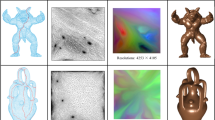Abstract
Automatic reconstruction of 3D objects from 2D orthographic views has been a major research issue in CAD/CAM. In this paper, two accelerating techniques to improve the efficiency of reconstruction are presented. First, some pseudo elements are removed by depth and topology information as soon as the wire-frame is constructed, which reduces the searching space. Second, the proposed algorithm does not establish all possible surfaces in the process of generating 3D faces. The surfaces and edge loops are generated by using the relationship between the boundaries of 3D faces and their projections. This avoids the growth in combinational complexity of previous methods that have to check all possible pairs of 3D candidate edges.
Similar content being viewed by others
Explore related subjects
Discover the latest articles, news and stories from top researchers in related subjects.References
Nagendra I V, Gujar U G. 3-D objects from 2-D orthographic views—A survey.Computer and Graphics, 1988, 12(1): 111–114.
Wang W, Grinstein G G. A survey of 3D solid reconstruction from 2D projection line drawings.Computer Graphics Forum, 1993, 12(2): 137–158.
Chen Z, Perng D B. Automatic reconstruction of 3D solid objects from 2D orthographic views.Pattern Recognition, 1988, 21(5): 439–449.
Meeran S, Pratt M J. Automated feature recognition from 2D drawings.Computer-Aided Design, 1993, 25(1): 7–17.
Masuda Hiroshi, Numao Masayuki. A cell-based approach for generating solid objects from orthographic projections,Computer-Aided Design, 1997, 29(3): 177–187.
Shum S P, Lau W S, Yuen M F, Yu K M. Solid reconstruction from orthographic opaque views using incremental extrusion.Computer and Graphics, 1997, 29(6): 787–800.
Shum S P, Lau W S, Yuen M F, Yu K M. Solid reconstruction from orthographic opaque views using 2-stage extrusion.Computer-Aided Design, 2001, 33(1): 91–102.
Idesawa M. A system to generate a solid figure from three views.Bulletin of the JSME, 1973, 16(92): 216–225.
Markowsky G, Wesley M A. Fleshing out wire frames.IBM J. RES. DEVELOP, 1980, 24(5): 582–597.
Wesley M A, Markowsky G. Fleshing out projection.IBM J. RES. DEVELOP, 1981, 25(6): 934–954.
Sakurai H, Gossard D C. Solid model input through orthographic views. InSIGGRAPH'83 Proceedings, 1983, pp.243–252.
Kuo M H. Reconstruction of quadric surface solids from three-view engineering drawings.Computer Aided Design, 1998, 30(7): 517–527.
Oh B S, Kim C H. Systematic reconstruction of 3D curvilinear objects from two-view drawings.Computers & Graphics, 1999, 23(3): 343–352.
Liu S X, Hu S M, Chen Y J, Sun J G. Reconstruction of curved solids from engineering drawingsComputer-Aided Design, 2001, 33(14): 1059–1072.
Liu S X, Hu S M, Tai C L, Sun J G. A matrix-based approach to reconstruction of 3D objects from three orthographic views. InProceedings of the Eighth Pacific Conference on Computer Graphics and Applications, Barsky B A, Shinagawa Y, Wang W (eds.), Hong Kong: IEEE Computer Society, 2000, pp.254–261.
Author information
Authors and Affiliations
Corresponding author
Additional information
This work is supported by the National Natural Science Foundation of China under grant No.69902004 and the NKBRSF of China under grant No.G1998030600.
Rights and permissions
About this article
Cite this article
Liu, S., Hu, S. & Sun, J. Two accelerating techniques for 3D reconstruction. J. of Comput. Sci. & Technol. 17, 362–368 (2002). https://doi.org/10.1007/BF02947315
Received:
Revised:
Issue Date:
DOI: https://doi.org/10.1007/BF02947315




